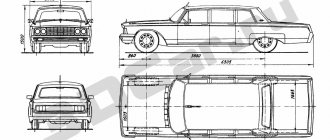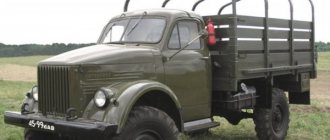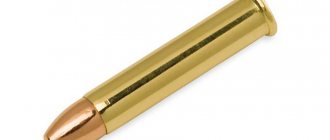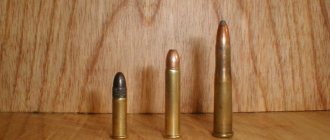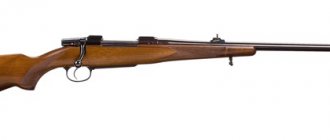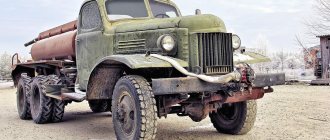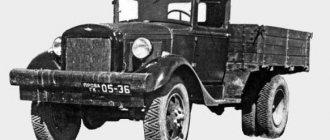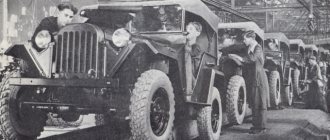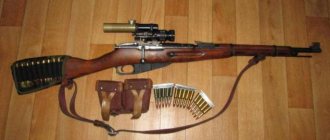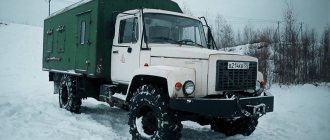The car was produced from 1941 to 1943. It was developed urgently, since the war was going on, and the army needed mobile equipment capable of transporting officers and transporting light guns in off-road conditions.
At the beginning of 1941, People's Commissar of Mechanical Engineering V.A. Malyshev gave the order to develop a light truck and do it within 3 months. Designer V.A. Grachev, engineer G.M. Wasserman and technician A.G. Kuzin worked on the project.
The task was not an easy one. The military set strict conditions regarding the parameters of the future car. Length, weight and wheelbase were strictly specified. A prerequisite was the possibility of placing a 30 mm gun. Particular attention was paid to the smoothness of the ride, which was necessary for targeted shooting while moving.
Where it all began
In the history of the domestic automotive industry there are many examples of copying foreign models. So they said about the GAZ-64 that this car was “copied” from the American Bantam BRC 40, although in fact the “sixty-four” has absolutely nothing to do with it. However, for the sake of fairness, it should be noted that the idea of creating a Russian “jeep” in this form was nevertheless borrowed from overseas allies.
Ivan Petrovich Tyagunov, Major General, Head of the Army Automotive and Tractor Directorate, while studying American automobile magazines on duty, came across an article in which it was reported that he had begun building “Pygmy” mini-trucks for the US Army. Moreover, the note indicated that the US military department was going to purchase 30 thousand of these vehicles - a simply huge figure for that time. This fact indirectly indicated the importance of a vehicle of this type for the armed forces. In addition, the body shape of the SUV and its technical characteristics were atypical for domestic cars.
By the way, the publication mentioned Bantam BRC only in passing, without any specific data.
Tyagunov got acquainted with the article in the last days of January 1941, and already on February 1, the People's Commissariat responsible for medium-sized mechanical engineering (NKSM) received a letter from the general with a convincing request to manufacture and present experimental machines developed on the Pygmy model by mid-April.
By the way, at that time the Americans actually had only two working copies of these cars.
V.A. Malyshev, who held the position of People's Commissar of the NKSM, summoned V.A. to Moscow. Grachev, who is the chief designer of GAZ off-road vehicles, and, having introduced him to the American publication, instructed him to make a car for the same purpose.
And here it is worth returning to the question of “copies”. Grachev had at his disposal a magazine with the general performance characteristics of the Pygmy. And it's all! The article did not contain any drawings, diagrams or simply information about the design. It was simply impossible to copy the car using the meager data available. So the merit of the Americans lies only in the idea.
“Timely” technical specifications
Work on the new car, which later received the factory marking GAZ-64, began on February 3. The car was assembled at an unprecedented speed, even surpassing the technical specifications that the factory workers received when the process of creating an SUV was approaching its final stage.
According to this document, the GAZ-64 characteristics had to correspond to the following data:
- Length (mm) – 3100.
- Track (mm) – 1200.
- Wheelbase (mm) – 2100.
- Hood height (mm) – 970.
- Weight (kg) – 1000.
- Minimum load capacity (kg) – 400.
- Cabin capacity – 4 people.
In addition, the GAZ-64 all-terrain vehicle was to be produced in three different versions: reconnaissance, command and artillery. tractor.
Moreover, for the first two types a phaeton-type body was assumed, and for artillerymen - a pickup truck.
In the reconnaissance vehicle, a swivel for the DS machine gun was to be installed in the interior, and on the GAZ-64, the command SUV, the RB radio station.
With the world on a thread...
In order to meet the allotted deadlines, engineers had to use units and components that had already been developed and used in other production cars. So, the designers borrowed the engine and gearbox from the GAZ-MM truck. From the GAZ-61 - the transfer case, front axle, steering gear, brakes (except for the drive system) and springs, adapting these elements to the new SUV. The rear axle, with shortened axle shafts, is from a GAZ-11. The wheel rims are from GAZ-M-1, and the tires are from GAZ-A. The carburetor and some other parts were taken from the first domestic small car KIM-10.
The following were developed from scratch: the supporting frame and the front suspension.
Instead of those indicated in those. Given the specification of body types (phaeton and pickup), Grachev decided to present the new model in one open version - a “cart” with cutouts that replaced doors.
A soft folding awning was not provided on the experimental GAZ-64.
Notes
- ↑ 1 2
"Volga" GAZ-21 • GAZ-22 • GAZ-23 • GAZ-24 • GAZ-24-02 • GAZ-24-10 • GAZ-24-12 • GAZ-24-24 • GAZ-24-34 • GAZ-24- 76 • GAZ-24-95 • GAZ-3102 • GAZ-31022 • GAZ-31029 • GAZ-3105 • GAZ-3110 • GAZ-31105 • GAZ-311055 • GAZ-3111 • Volga Siber Executive models ZIM • Cars “Chaika” :
GAZ-13 “Chaika” ; GAZ-14 “Chaika”
• GAZ-3105All terrain GAZ-21 • GAZ-61 • GAZ-64 • GAZ-67 • GAZ-69 • M-72 • GAZ-46 • GAZ-2308 “Ataman” • GAZ-3106 Utility, sports and experimental models GAZ-4 • GAZ-61-417 • GAZ-A-Aero • GAZ-AAA • GAZ-VM • GAZ-25 • GAZ-GL-1 • GAZ-67-420 • M-73 • GAZ-16 • GAZ- 18 • GAZ-19 • GAZ-415 • GAZ-3103 • GAZ-3107 • GAZ-2301 • GAZ-2304 “Burlak” • GAZ-3115 • GAZ-3301 • GAZ-2332 CityVan
Interrupted testing of the new SUV
In April 1941, the “sixty-fourth” had to undergo almost two-week military tests, on special tests. Kubinka training ground, which also featured: AR-NATI, GAZ-61 and a guest from Germany – Tempo G1200.
In fact, only AR-NATI could provide more or less fair competition to the GAZ-64, when the other two cars belonged to cars of a completely different class. But nevertheless, all four models were put on the “same line” and compared with each other.
During testing, the new “jeep” covered 776 km, of which 126 were over very rough terrain, at the very peak of the spring thaw, both independently and with a trailer, which was an artillery limber along with a “magpie” cannon. The GAZ-64, a military vehicle, showed simply excellent cross-country ability, comparable to the capabilities of the T-60 and T-40 light tanks, and this was not with “mud tires,” but with ordinary tires from a production vehicle.
However, the car was not allowed to go through the entire testing program; the tests were interrupted due to the fact that Stalin, Budyonny, Voroshilov and Shaposhnikov wanted to personally inspect the new off-road cars.
Car history
Domestic passenger car of mass production - Gas M1 "Emka".
The first work on the creation began in 1933, and already in January 1934 the first pre-production samples of the model appeared.
This car has passed the highest state approval. In March 1936, the car was inspected by Joseph Stalin, Kliment Voroshilov, Vyacheslav Molotov and Grigory Ordzhonikidze. They liked the car.
In 1936, mass production began, Emka replaced Model A on the assembly line.
A total of 62,888 cars were produced between 1936 and 1942.
GAZ M-1 is truly a symbol of the 30s. “Emka” was first and foremost a company car; this car was used by frontline workers, cultural figures, party nomenklatura, factory directors, and military commanders. However, the car was also sold to ordinary citizens. To buy an M1, a mere mortal had to get a good reference at his place of work and, of course, pay. The car was sold for 10,000 rubles, with an average salary of 350 rubles.
Military verdict
Despite the fact that the new SUV showed extraordinary cross-country ability, the military issued a simply devastating final verdict.
In its report, the commission indicated that the technical characteristics of the GAZ-64 generally meet the requirements, but there are differences on some points, namely:
- A range of 334 km is not enough for efficient operation.
- In very rough terrain, the engine cooling system does not work well even at an ambient temperature of +5 degrees.
- GAZ-64 is not able to overcome a water barrier more than 600 mm deep.
- On wet and unstable ground, the climb can be overcome only 17-18 degrees.
Based on the body layout, according to the commission, the new car is not suitable for any of the roles specified in the technical specifications. task, but is an ordinary passenger semi-truck designed for three people and a small amount of luggage. And this despite the fact that he had no problems dragging an anti-tank gun along with its front end through the melted snow mixed with mud.
In addition, the review was influenced by the lack of an awning, a spare tire, and an additional fuel tank.
As a result, the military considered the production of the GAZ-64 inappropriate, preferring the GAZ-61 to it. At the same time, without taking into account the fact that the production of the engines installed on this car (GAZ-11) had already been discontinued, and there was even no necessary equipment for the manufacture of the open body platform on which they insisted.
Navigation¶
2020/04/17 12:44 Obsidian has updated the AIGS GraFiS page. 2020/01/19 16:59 Obsidian has updated the Air Compressibility Ratio page. 2019/08/17 15:24 Obsidian has updated the Barrel A page. 2019/08/17 15:24 Obsidian has updated the Barrel B page. 2019/07/18 10:44 Aleksey updated the page Linear speed of combustion propagation. 2019/04/10 14:10 Obsidian has updated the Siberian Fire and Rescue Academy page (Siberian Fire and Rescue Academy). 2019/01/23 15:56 Obsidian has updated the Online GDS calculator page. 2019/01/23 09:32 Obsidian has updated the AIGS GraFiS page. 2018/12/04 11:01 Obsidian has updated the Fire Extinguishing Agents page. 2018/11/11 16:12 Obsidian has updated the Path Traveled by Fire page. 2018/11/11 16:08 Obsidian has updated the Online GDS calculator page. 2018/11/04 20:15 Obsidian has updated the Online GDS calculator page. 2018/09/03 11:21 Obsidian has updated the Pump and Hose Systems page. 2018/08/27 09:34 Obsidian has updated the page Extinguishing fires in buildings with hinged ventilated facades. 2018/07/31 16:54 Obsidian has updated the page Calculation of operating parameters in RPE. 2018/07/31 15:00 Obsidian has updated the page Calculation of operating parameters in RPE. 2018/07/24 09:26 Obsidian has updated the page Calculation of operating parameters in RPE. 2018/07/17 14:46 Obsidian has updated the page Calculation of operating parameters in RPE. 2018/06/19 20:56 Tor updated the page Combined fire extinguishing graph of changes in fire area, required and actual consumption of fire extinguishing agents over time. 2018/05/18 16:40 Obsidian has updated the Firefighting Operations Headquarters page. - Random page
- New page
- All pages
- Categories
- Files
- AA 11.8-100 (RBI 39.700) PANTHER
- AA 8.0-90/6(65224)
- AA 9.0-(60-70)-50/3(65222)-33VR
- AA-12.0-60 (63501)
- AA-12/60(63501)-270.02
- AA-13/60(6560)-270.03
- AA-13/60 (6560)
- AA-40(43105)189
- AA 8.5-70(43118) – Pozhavto
- ABR-5(4308)
- ANR 40-1.4(43118)
- ANR 40-800(43253)
- APP 3(2705) Pozhavto(Miass)
- APP-0.3-2.0(33021)PM-532A
- APP-0.3-2.0 NATISK(27057)
- APP-0.5(396255)
- APP-0.5(Iveco Daily)
- APP-0.5-1.5(3302)-85VR
- APP-0.8-20/200(65C15DH)027PV
- APP-2-0.3/100(23602)023-MS
- APP-5(Ford Transit)Pozhavto
- AC 5.0-100(43118)
- AC 5.0-100(43118)-2
- ACA-40/4(43118)-248
- Fire truck markings
- Basic fire trucks
- Basic general purpose fire fighting vehicles
- Main fire vehicles for specific purposes
- Fire trucks
- First aid fire trucks
- Fire hose vehicles
- Special fire trucks
Fire trucks, pump and hose
Pages with links to this article
- AA 11.8-100 (RBI 39.700) PANTHER
NP 4000
Pages linked to in this article
Site search
Special opinion
Accompanying the test report, Grachev attached his written opinion, explaining in it what the GAZ-64 is and what its purpose is, namely:
- that this SUV was intended, first of all, for use in army engine units, the compactness of the vehicle is connected with this;
- that according to those requirements imposed by the Main Armored Directorate, the vehicle can be used in all three directions: command, reconnaissance, artillery. tractor.
- that it is impossible to compare the new SUV with the GAZ-61, since these cars belong to different classes, and the “sixty-four” is not intended to replace, but to complement it.
It is unknown whether the arguments that Grachev gave would have been enough to defend and still put the GAZ-64 into mass production, but then he received unexpected help from the Hero of the Soviet Union, Marshal G. I. Kulik. Kulik wrote a letter to Malyshev in which he stood up for the GAZ-64, justifying the need to put a vehicle of this class into service in the Red Army, naturally, with the elimination of the shortcomings identified during the tests.
Engine
The next main characteristic is the car engine. What does a beginner need to know about engines? Volume (the power of the car and its consumption depend), the number and location of cylinders and valves (motor efficiency), power (usually in hp (horsepower)).
The engine is connected to a gearbox, which can be mechanical, automatic, robotic, or it can be a CVT. All of these options have their advantages and disadvantages that you should definitely be aware of.
Moreover, different models of different types of boxes have their own weak points, which should be checked when buying a car. One way or another, in the end, the operation of the engine and gearbox drives the wheels, which show another one. parameter - torque, calculated in Nm (Newton meters)).
Second try
At the very beginning of the summer of 1941, another and only prototype appeared, seriously redesigned: the body underwent radical changes, the car acquired an awning and a spare wheel, and the SUV chassis was also improved. GAZ-64, according to the plan, was to be tested again, but the outbreak of war prevented it. Two days after it began, the Gorky Automobile Plant received the task of producing a couple more updated vehicles: a command vehicle and a reconnaissance vehicle. On August 20, both SUVs arrived in Moscow for testing, with an additional one carrying a “forty-five” gun, the second a 57 mm anti-tank ZIS-2.
The tests were successful, and this time the new SUV was put into service and put into mass production.
GAZ-64: characteristics, description
The car body is welded, open, with four seats. The front seats are separate, the rear seats are solid. Doors, as in the first version, were not provided, which made it possible to quickly leave the car in case of danger. The entire surface of the body eliminated complex shapes, which facilitated its mass production.
The waterproof awning covered only the top, the sides remained open.
The windshield could be lowered forward (on the hood).
For the external design of the front of the car, parts from GAZ-AA were used: hood cover, top of the radiator casing, instrument panel.
The “jeep” was equipped with a carburetor four-cylinder engine with a volume of 3.285 liters, the low compression ratio of which (only 4.6) made it possible to use even low-quality fuel (55–60 octane). Engine power 50 hp. With. at 2800 rpm allowed the SUV to accelerate to 90 km/h.
Gearbox – four-speed, manual. The transfer case is single-stage. The main drive is rear-wheel drive, front-wheel drive is plug-in.
The SUV's suspension used quarter-elliptic springs - not the best option, since the leafs often broke when overloaded.
Longitudinal swaying was damped by single-acting hydraulic shock absorbers. A stabilizer installed in the rear suspension was responsible for lateral stability.
On all wheels, the braking device was activated via a mechanical drive (cable).
Body
Next comes the body. Bodies are open and closed. The most popular closed body is the sedan. The sedan comes not only with four doors, but also with two doors, which often leads to confusion with the coupe.
A sedan has two rows of seats for the driver and passengers, and all of them are full. A coupe usually has two doors (an example of a four-door coupe is the Mazda RX-8), but the main thing is a defective or absent rear row.
A station wagon is practically the same sedan, only there is a cargo compartment in the back instead of the usual trunk. A station wagon can be confused with a hatchback, which is shorter and smaller. In addition, there is a type of hatchback - a liftback (a hatchback with a long overhang and usually a sloping roof).
These are only the main varieties, because there are also limousines, minivans, minibuses, hardtops, town cars, combis, frame and frameless SUVs, SUVs, pickups, roadsters, chaises, convertibles, landaulets, brogams, targas, spiders and fastbacks.
Production
Already in August 1941, the car plant produced a batch of 42 cars, and in early autumn - another 190 copies. A total of 601 cars rolled off the assembly line by the end of the year. It was during this period that the bulk of “jeeps” were produced. Then production began to decline, due to the fact that, based on the GAZ-64 chassis, the plant began to produce BA-64 armored vehicles, which, for obvious reasons, were a priority. So, until mid-spring 1943, another 85 cars were manufactured, and from the end of the year, the “sixty-four” was replaced by the GAZ-67, popularly nicknamed “Ivan-Willis”, or simply “Soviet Willis”. GAZ-64 became the base model for this car.
Racing for survival: Soviet jeeps in the Great Patriotic War
Thanks to the work of the leading designer V.A. Grachev, in the new Russian-style solid and unpretentious army vehicle GAZ-64, for the first time it was possible to do without direct copying, use all components and assemblies of domestic production and acquire a well-known typical army appearance.
GAZ-64 (1941–1943)
Officially, this basic multi-purpose command vehicle was designated GAZ-64-416 , where the last three digits indicated the body type. Its basis was a shortened GAZ-61 chassis with a 50-horsepower engine from a GAZ-MM truck, a water pump from a GAZ-11 engine, a radiator of reduced height and a new front suspension on quarter-elliptical springs.
| Serial all-wheel drive command vehicle GAZ-64. August 1941 |
Fundamentally new was an open four-seater body with an awning and canvas aprons in the doorways, a spare wheel on the rear wall, narrow front tin fenders with rounded edges and characteristic recesses for headlights. The massive hood with rear exhaust slits received a flat radiator lining, which was welded from ten vertical metal rods. The body provided space for placing small arms and ammunition.
| All-terrain vehicle GAZ-64 with an open utilitarian four-seater body model 416 |
| Army jeep GAZ-64 with a tilt body and aprons in the doorways |
The wheelbase of the GAZ-64 was 2100 mm, the curb weight reached 1.3 tons, and the maximum speed was 92 km/h. Thanks to the stable operation of the unpretentious engine, it showed high maneuverability, was quite durable, compact and easy to operate and maintain. Its main disadvantage was the narrowed front and rear tracks (1278 and 1245 mm), which did not provide sufficient lateral stability and the ability to move in a column along the track of vehicles in front.
| Restored GAZ-64 all-terrain vehicle with a light anti-tank gun |
The first batch of 42 GAZ-64 cars, assembled by hand in August 1941, was immediately sent to the front, and the next 190 cars made it possible to talk about the beginning of their small-scale production. By the end of the year, the Red Army received about 700 vehicles. Meanwhile, America, always serving as a role model, quietly assembled its prototypes, suspending the production of the not very successful Willys MA model. Only in mid-November, when Soviet GAZ cars were crushing the enemy near Moscow, did mass production of the most famous Willys MV jeep begin. This “temporary gap” of three months (from August to November) gives every right to call the USSR the world leader in the field of jeeps.
In the Red Army, the GAZ-64 was used mainly as a command and staff vehicle, and was also used to transport up to six soldiers, deliver urgent reports and tow various types of guns. On a trial basis, a Maxim machine gun and a light 37-mm ChK-M1 anti-tank gun were mounted on it.
| The GAZ-64-416 all-terrain vehicle with a 45-mm cannon crosses a water obstacle. 1943 | Airborne cannon ChK-M1 from military plant No. 8 on a GAZ-64 vehicle. 1944 |
And yet, the GAZ-64 never received distribution in the Red Army. Serious shortcomings became even more obvious with the beginning of mass deliveries of more advanced armored vehicles under Lend-Lease. Until April 1943, the Gorky Plant assembled 762 GAZ-64 vehicles, and then until August it produced only chassis for armored vehicles.
As a result, the most numerous and famous vehicles in this series were not the first Soviet jeeps, but the BA-64 light armored vehicles based on them.
Armored vehicles BA-64 on GAZ-64 chassis
With the advent of the fundamentally new army all-terrain vehicle GAZ-64 in July 1941, under the leadership of Grachev, the development of a whole family of compact machine-gun armored vehicles BA-64 began. They had more reliable armor protection, high mobility, sufficient maneuverability and were used for reconnaissance, combat control, patrol service and security of objects. At first, the Vyksa DRO plant was engaged in the production of armored hulls and turrets; later their assembly was transferred to GAZ.
| Experienced armored car BA-64-125 on the GAZ-64 chassis. March 1942 |
In January 1942, an unfinished model of the BA-64-125 appeared with a tank machine gun on a turret in the upper hatch of the hull, which included all the design principles and solutions that were actually implemented throughout the entire BA-64 family. After modification, it was put into service and, from April, was mass-produced as the basic version of the BA-64 with a bulletproof armored hull, an open full-moving machine gun turret, one left blackout headlight, and regular or bullet-resistant tires. The base vehicle was followed by a trail of experimental armored vehicles, created in single samples in the first three years of the war.
| Pre-production sample of the future machine-gun armored car BA-64 |
| Basic production version of the BA-64 with a fully rotatable turret. April 1942 |
The prototype of the BA-64V armored rubber tire was a railway version of the BA-64 serial vehicle with four metal wheels with flanges, which replaced conventional wheels with pneumatic tires. On the rails its speed reached 85 km/h. The next trial turret version of the BA-64D with a heavy machine gun turned out to be too unstable. The experienced turretless transport vehicle BA-64E with a soft top served as a light armored personnel carrier for the delivery of five to six paratroopers.
1 / 3
2 / 3
3 / 3
The most original was the “winter” ski-tracked armored vehicle BA-64Z for movement in deep snow. For this purpose, a rear mover with driving tracks and two front steerable skis were used. In real conditions, the armored car turned out to be uncontrollable.
| Experimental ski-tracked armored vehicle BA-64Z. January 1943 |
GAZ-67 (1943–1946)
The innate instability of the GAZ-64 cars, inherited from the United States, led to the creation of a modernized and more powerful version of the GAZ-67, designed by engineer G. M. Wasserman, where many of the shortcomings of its predecessor were corrected. Its design began in mid-February 1943, and in the summer advanced prototypes were born. On September 23, after eliminating the consequences of the devastating bombing of the Gorky Automobile Plant, a new, wider GAZ-67 entered the assembly line.
| An open GAZ-67 with a widened track and angular wings. September 1943 |
The main difference between the base GAZ-67-416 car was the front and rear tracks increased to 1446 mm, which led to minor changes to the previous body and controls: side steps and small rectangular rear wings appeared, and wider front ones acquired sharp angular outlines. In addition, the mountings for the steering gear and spare wheel were changed.
| A typical army jeep GAZ-67-416, in all respects close to the Willys MV |
When installing a new carburetor, the engine power increased to 54 horsepower - the level of the American Willys MV. At the same time, the suspension and frame were strengthened with an additional rear cross member. The curb weight increased to 1.4 tons, ground clearance was 227 mm. The maximum speed is 90 km/h, the reference fuel consumption is 14 liters per 100 km. If necessary, the GAZ-67 could withstand short-term overloads, transporting up to 15 people at a time.
| Factory tests of the GAZ-67 with a 76-mm ZIS-3 cannon. 1943 | Light engineering drilling rig on the GAZ-67 chassis. 1945 |
In addition to the standard functions inherited from the GAZ-64, new types of weapons were installed and tested on the GAZ-67 model, light engineering equipment and more convenient closed bodies were installed. In 1943, the bus branch of the Gorky Automobile Plant assembled the only covered all-terrain vehicle GAZ-67-420 with a glazed two-door plywood body model 420. At the same time, military repair plant No. 90 built its own closed version with narrower side windows.
In total, about five thousand GAZ-67 vehicles were built.
| Experimental car GAZ-67-420 with a closed body. October 1943 | Covered headquarters jeep GAZ-67 with a body from military plant No. 90. 1943 |
Armored vehicles BA-64B on GAZ-67 chassis
The less extensive family of light armored vehicles BA-64B based on the GAZ-67 was a direct development of the first series of BA-64, from which it differed primarily in the widened track of both axles, slightly increased power of the power unit, enhanced armor protection and improved driving performance.
| Basic armored vehicle BA-64B with a wide gauge, in the background - a narrow-gauge version of the BA-64 |
Since September 1, 1943, the modernized basic armored car BA-64B with increased thickness of armor plates and increased stability was mass-produced, replacing the BA-64 model. In contrast, two additional hydraulic shock absorbers were installed in the front suspension, the axle housings of both axles were strengthened, and a new radio station was installed.
| New basic armored car BA-64B on an extended GAZ-67 chassis |
| Light armored car BA-64B in service in the People's Army of the GDR. 1950 |
In 1944, 15 modernized BA-64B railway armored cars with replaceable metal bands for movement on rails were assembled. The development of the BA-64V railway armored cars was a modified version of the BA-64G based on the BA-64B with folding longitudinal brackets with springs and small guide rollers lowered onto the rails.
| Railway armored car BA-64G with guide rollers. 1943 |
In 1943, three turretless BA-64E transporters of the second experimental version were built with an extended aft door and holes in the hull with armored flaps. Their test results were negative. Subsequent modernization led to the creation of light staff vehicles BASH-64B with a reduced height of the working compartment with space for two to three crew members.
| The second version of the BASH-64B transport and landing armored vehicle. 1944 |
| A converted turretless BA-64B vehicle with a hand-held anti-tank rifle. 1944 |
During the war, the Red Army used turretless armored vehicles with powerful types of light weapons, and with the advent of peace, BA-64B armored cars led the post-war Victory Parades in almost all Soviet cities.
1 / 3
2 / 3
3 / 3
GAZ-67B (1944–1953)
In November 1944, the modernized military vehicle GAZ-67B replaced the previous version of the GAZ-67, and in peacetime it became the most popular multi-purpose all-terrain vehicle for agriculture. It was equipped with a reinforced front axle with new bearings, a modernized suspension and driveshaft, a new carburetor, gasoline filter, ignition distributor, etc.
| Modernized army vehicle GAZ-67B. November 1944 (from the NATI archive) |
In the first four years of production, the GAZ-67B differed from its predecessor only in the three-spoke steering wheel, but in 1948 its main distinguishing feature was the stamped radiator lining with wide air intake windows.
| Multi-purpose four-wheel drive vehicle with stamped front fascia. 1948 |
| One of the last all-wheel drive all-terrain vehicles GAZ-67B in the Soviet army. 1951 |
This all-terrain vehicle was no longer widespread in the Armed Forces of the USSR, although until the mid-50s it continued to perform the functions of both of its predecessors. Special bodies were mounted on it, new types of weapons were tested, and road trains consisting of jeeps with guns were among the first to be used to deliver light armored vehicles in the holds of transport aircraft and helicopters for landing.
| GAZ-67B with an experimental body for delivery of combat crews and ammunition. 1947 (from the archive of N. Markov) |
| Landing of a GAZ-67B jeep, delivered in the hold of a Mi-4 helicopter (film frame) |
GAZ-67B jeeps participated in military parades until the mid-50s, until they were replaced by the new GA3-69 army vehicle.
| All-terrain vehicles GAZ-67B of the first production at the parade in Moscow. May 1, 1947 | GAZ-67B cars of the second series at the parade in Moscow. May 1, 1952 |
In the title photo are the most famous Soviet army all-terrain vehicles of wartime: on the right is the modernized GAZ-67 jeep, in the background is the first version of the GAZ-64.
This article uses only authentic black and white illustrations.
GAZ-64: reviews
To date, there is no information about the surviving example of at least one example of the first Soviet “jeep”, and besides, due to the small total number of vehicles produced, it was not widely used in the army, but it left a memory of itself among the front-line soldiers.
In general, the reviews were positive, but still many believed that the car turned out to be rather “crude”: frame elements, steering bipods, and front springs often broke, the car was quite difficult to drive, there was a high consumption of fuel and oil, especially under load . In addition, not very good brakes created additional problems. But the gearbox worked much better than on the American Willys, and, unlike it, almost never failed.
Another problem of the GAZ-64 was that the wheel track was too narrow (similar to the American Pygmy): the car did not fit into the knurled tracks of trucks, which added to the difficulties in driving. For the same reason, the car had poor lateral stability, which sometimes even led to its capsizing.
However, despite the obvious flaw in the car’s design, front-line soldiers loved it for its phenomenal cross-country ability, in which it was superior to the Willys, as well as its unpretentiousness, which could not be said about the “American”, which often broke down due to poor fuel. In addition, thanks to this particular car, the GAZ-67 was born, in which all the identified shortcomings of the “sixty-four” were taken into account and eliminated.
Possible truck malfunctions
In addition to relatively minor faults that do not take much time to repair, there are also more serious problems. First of all, we are talking about problems with hydraulics.
On the one hand, the driver will continue driving to the place where there are tools for repairs. On the other hand, the car remains for a long time without proper technical inspection. Drivers do not attach importance to the leak that appears; as a result, after 1-2 months the car becomes unusable. In addition to hydraulic fluid, truck hydraulic cylinders often fail.
This is what a hydraulic cylinder for lifting the body of a GAZ SAZ 3507 looks like
The manufacturer made sure that the GAZ 3307 and its cargo modification could cope with various loads:
- hard loading and unloading;
- transportation of oversized items;
- driving on a dirt road;
- operation in harsh weather conditions.
Depending on the intensity of driving, the driver is required to do a preventive examination every 3 months.
The primary focus is on the hydraulic system, housing and engine. Despite the fact that the vehicle diagram does not include parts that are difficult to find, there is no need to allow serious damage
The problem is that one breakdown often provokes a chain reaction. For example, when hydraulic fluid begins to leak, the engine starting circuit fails. A temporary, seemingly simple defect will result in a lengthy and expensive repair. If you are planning a long trip, it is strongly recommended to take material with you for carrying out repairs along the route.
First of all, you need to pay attention to hydraulic pipes, hydraulic units, body mounts and oil
Why “sixty-four” and not AR-NATI?
Let us recall that AR-NATI was tested together with the GAZ-64 and at the same time was in the same class with it, and during the tests this car in some respects even surpassed Grachev’s SUV. However, the car had insufficient unification with production cars, and its design was more complex and expensive, which naturally played against it.
Therefore, even a slight superiority over the GAZ-64 could not outweigh the economic component of the project. “Sixty-four” was simpler and much cheaper than its competitor, which was the determining factor in the choice between the two models.
What can be concluded?
The GAZ-64 car, despite its short history, played a huge role in the domestic mechanical engineering. In the future, many Soviet off-road vehicles were built on its basis, which were used not only to resolve local conflicts, but also international ones. For its time, the design turned out to be advanced, although it was made with an eye on British transport.
